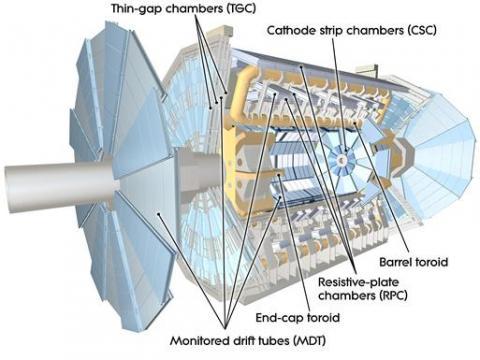Muon Spectrometer elements
The image was taken from: computer generated images 2008
Latest update: 30.08.2017 - Version 0
Design facts and figures
- Thin Gap Chambers (TGC) for triggering and 2nd coordinate measurement (non-bending direction) at ends of detector. 440 000 channels.
- Resistive Plate Chambers (RPC) for triggering and 2nd coordinate measurement in central region. 380 000 channels, electric field 5 kV/mm
- Monitored Drift Tubes (MDT) measure curves of tracks. 1171 chambers with total 354 240 tubes (3 cm diameter, 0.85-6.5 m long). Tube resolution 80 micron
- Cathode Strip Chamber (CSC) measure precision coordinates at ends of detector. 70 000 channels, resolution 60 microns.
Images and videos
- A video describing how the detector works on the ATLAS web site detector presentation
- Photos: "best of ATLAS" series on the muon detectors construction & installation
- 2017 video on the ATLAS YouTube channel Muons on the move
Main contributors stories and timeline
- ATLAS public web site updates tagged as muon-spectrometer tell some of the stories
- TBD - ATLAS25 Bratislava talk
Run 2 achievements
Compilation of LS1 LHCC reports 2013-2015:
LS1 saw the completion of the muon spectrometer as described in the original TDR by installation of the last missing chambers in the transition region between barrel and endcap and the elevator shafts. This improved the momentum resolution in the region eta 1 to 1.3 and the acceptance for high Pt analyses. All subsystems went through standard maintenance and consolidation work : check and repair gas leaks, replace some chambers, installation of new sensors. The fake trigger rate was reduced by ~30% in Endcap by using more TGC in the trigger logic. Adding coincidences with the Tile calorimeter information decrease the rate further. Running at 100 kHz, the L1 rate expected for Run-2, was achieved and on-going developments improved the stability at higher occupancy. The muon reconstruction software was updated and improved.
In the public papers & CONF notes, a 2016 paper on the Muon reconstruction performance @ 13 TeV:
The MS is designed to detect muons up to eta = 2.7 with an efficiency close to 99% (checked using Z and J/psi), and to provide momentum measurements with a relative resolution better than 3% over a wide pt range and up to 10% at 1 TeV.
RPC and TGC provide triggering capacity as well as position measurements with a typical resolution of 5 – 10 mm. MDT, and at high eta CSC, provide 6 to 8 measurements along the trajectory with a single hit resolution of 80 and 60 microns. The muon chambers are aligned with a precision between 30 and 60 microns. The material between the interaction point and the MS consists mostly of calorimeters and ranges from 100 to 190 radiation lengths.
Muons are key to some of the most important ATLAS physics results: measurement of the Higgs boson properties, of standard model processes involving Z and W bosons, and searches for new physics [e.g. high mass resonances or leptonic channels with missing energy]. Muons originating from the decay of heavy particles are often produced isolated from other particles, unlike muons from semileptonic decays which are embedded in jets. The measurement of the detector activity around a muon candidate, referred to as muon isolation, is therefore a tool for background rejection. Tracking and calorimeters are used and combined to define 7 isolation working points, optimised for different analyses. The variations observed on data are well reproduced by the simulation.
Future challenges
In the 2015 ATLAS Phase-II Upgrade plans:
Phase-I : at local hit rates about 500 Hz/cm2 the MDT will start to lose spatial resolution and efficiency due to build-up of space charge in the gas volume. In places where this limit is reached, the MDT chambers will be replaced by new ones, with a smaller tube diameter. The new Small Wheels (nSW) are expected to eliminate 3 sources of fake triggers in the end-cap.
Phase-II : due to the expected increase of luminosity and radiation damage, the HL-LHC upgrade presents significant challenges to detectors, readout system and trigger. MDT readout cards must be replaced to cope with the rate, as well as the RPC barrel trigger system and the RPC readout. All of these will take advantage of the evolution of technology since the mid-nineties. For example the improvements in optical links will allow to move some cards away from the detector. The replacement of the Front End electronics will require chambers to be removed from the detector and re-installed, ans for this access structures to be moved around. Several teams will have to work in parallel, for a total time of 1.5 to 2.5 years.
The Muon Phase-II TDR: is in the approval phase
- A CERN bulletin article on the New Small Wheels [ 15.08.2018 ]
How much of it can we see @P1 ?
- Muon big wheel as seen on the detector panorama
- TBD during next EYTS !

